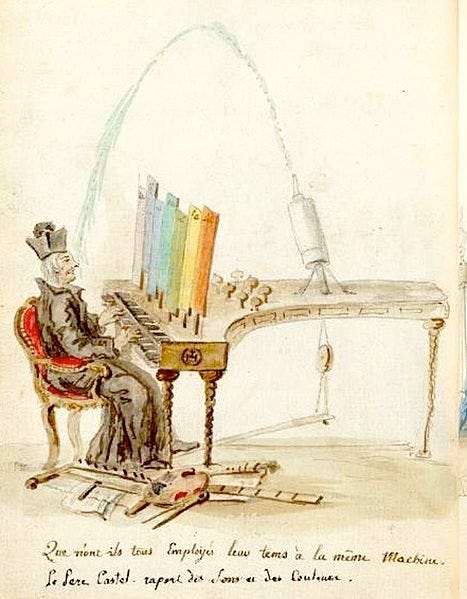As early as the 1500s, artists, inventors, and scientists were trying to represent sound as something visual. These folks believed there was a direct mapping between color and sound. Many sought to create machines––called color organs––that would represent sound visually.
French Jesuit monk Louis-Bertrand Castel undertook one of the earliest attempts to create a color organ. In a 1725 letter published in a French cultural journal (Mercure de France), he proposed the “ocular organ,” shown above. His letter set out to prove a direct relationship between musical notes and colors. He argued that what music accomplishes with sound––arranging different tones in such a way that we appreciate the effect as a form of art––could also be accomplished with color. In turn, Castel wanted to create a “music of colors.”
Castel’s semi-scientific argument for the validity of color music rested largely on Newton’s Opticks (1704). Castel took Newton’s succession of colors––the rainbow––and treated it as a musical scale. Each color would correspond to one note in the scale. (It’s worth mentioning that Newton had rather explicitly rejected any relationship between sound and light… but this didn’t seem to bother Castel.)
For the next decade, most of Castel’s work on the color organ was theoretical––until 1734, when he finally attempted to build one. The next few years of his work were plagued by failed prototypes, a lack of funding, and waning motivation. But, in 1739, he showed the organ (or, more accurately, a model of the organ) to German composer Georg Philipp Telemann. It’s thanks to Telemann that we have a first-hand account of how Castel’s organ worked:
“To have it sound a tone, one touches a key with a finger and presses it, and thereby a valve is opened that produces the chosen tone. … At the same time, when the key opens the valve to produce the tone, Father Castel has fitted silken threads or iron wires or wooden levers, which by push or pull uncover a colored box, or a ditto panel, or a painting, or a painted lantern, such that at the same moment when a tone is heard, a color is seen.”
Telemann, so inspired by the organ, composed several original compositions for it. Sadly, these compositions have been lost, so nobody knows what they sounded or looked like. (This didn’t stop some contemporary British artists from attempting to recreate Telemann’s compositions in early 2020.)
Castel’s final performance with the organ took place on January 1, 1755, with two hundred people in attendance. It’s hard to know exactly how well the organ functioned at the 1755 concert (it, like Telemann’s compositions, has been lost to time), but it was likely just an elaborate prototype. Castel, after this show, stated that the organ was “so far … from being perfect.” But, sadly, he didn’t have time to fix the flaws; Castel died two years later.
By most measures, Castel’s organ––in its many iterations––was unsuccessful. But, through this work, Castel opened a new line of inquiry into color theory and inspired many followers to build color organs. In 1877, American inventor Bainbridge Bishop created light attachments for pipe organs that synchronized colored lights with music. In the 1920s, artist Thomas Wilfred created boxes of moving light (the Clavilux) that were designed to evoke a sense of the musical. In 2000, Jack Ox and David Britton created “The Virtual Color Organ,” a computational system for translating musical compositions into 3D visual performances.
So, attempts continue––scientists and artists alike trying to create a definitive mapping between the auditory and the visual, trying to create music out of color.
Notes:
Franssen’s essay on Castel’s organ was my primary source.
Wikipedia has a useful catalogue of color organs through time.
Here’s a good blog post on another color organ by Alexander Wallace Rimington.
Fred Collopy has collated a wonderfully comprehensive bibliography of articles on visual music.




